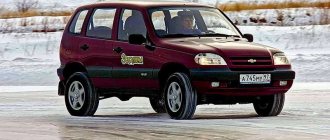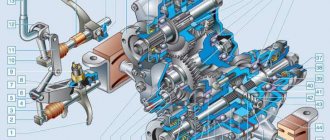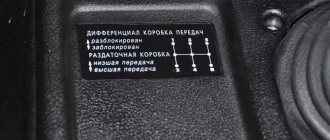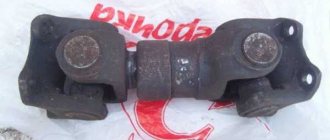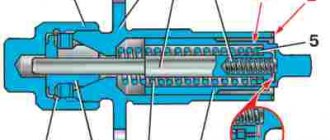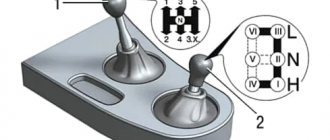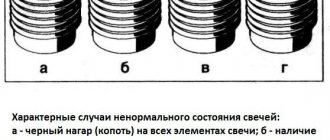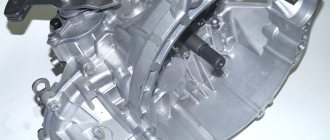The Chevrolet NIVA SUV is equipped with a five-speed gearbox, as well as a transfer case with a range and a center differential lock.
When purchasing this car for the first time, the car owner does not always know how to use such a transmission correctly, when and under what conditions it is necessary to engage the lock, and when to lower it.
When to use low gear
How to use the transfer case on a Chevrolet Niva is a question that many owners of this car ask.
The Chevrolet Niva is a popular Russian SUV not only among extreme driving enthusiasts, but also for those who use the car for personal purposes. Everyone knows that the car is equipped with a transfer case, which is responsible for engaging the lock and downshift. It is worth noting that all this can be done even simultaneously and this is done using one lever. So, in order to use a lower gear, you need to shift the lever first to the right and then up, but of course, in order to engage in a higher gear, you just need to shift the lever back.
Note that the transfer case can be used to engage neutral gear, which will prevent the car from moving. You can engage the lock both in high gear and in low gear; to do this, you just need to switch the lever to the left.
There is a diagram on the shift lever. To engage a downshift, you need to move the lever to the right, up. To lock the differential, pull it all the way to the left. There are also Latin letters on the lever. So, L is a low gear, N is neutral, and H is high.
By switching the operating modes of the transfer case, you can adjust the behavior of the car in accordance with road conditions.
Low gear is used in two cases:
- It is necessary to ensure low speed. For example, if you need to drive onto a curb or other obstacle, you can engage a lower gear so as not to burn the clutch.
- Need high torque. A lower gear is engaged before overcoming steep inclines.
The differential lock is activated when driving off-road, where there is a high risk of slipping.
At the same time, it must be turned on before entering a difficult area.
In general, you need to use the transfer case like this:
- Driving on the highway. The differential is unlocked, the first speed of the RK is turned on.
- Overcoming climbs and obstacles on hard surfaces. The differential is unlocked and the reduced speed is engaged.
- Overcoming difficult snowy areas, mud, slippery climbs. Locking and reduced speed enabled.
For what purpose is a transfer case even needed, when does it make sense to engage the locking and downshift? Such seemingly simple, but at the same time serious questions will become clear when considering the following example. When driving on a country road on a hard surface, fourth gear is engaged. Suddenly, a large puddle with a soft, unreliable surface appears in front of the car.
It is worth noting that in order to engage a lower gear on a Niva Chevrolet, you need to stop - this is how the car’s differential is designed. But you don’t need to stop at all to turn the lock on and off. But is it worth using such additional and, without a doubt, useful functions of the machine often? Experienced drivers recommend using them in places where the dirt is not located on level ground, but with various potholes and the like.
Thus, the low gear of the Chevrolet transfer case is designed for comfortable off-road driving and overcoming various obstacles. In such a gear you need to drive slowly, you cannot accelerate sharply, because at this moment the wheels will receive a large load, as a result of which a real hole can form, from which it will be very difficult for the car to get out.
With this driving style, the motorist will better feel the movement of the wheels, as a result of which, when they “bury”, as evidenced by the chaotic movement of the car, it will be possible to immediately do something after overcoming the obstacle. Most often, this is done by changing the trajectory of the car.
It is also worth noting that when driving through sticky mud or deep puddles, you should never suddenly engage second downshift. At the same time, the torque increases, as a result of which the car can simply “choke”, stalling at the most inopportune moment.
Front axle device
In a Niva-Chevrolet car, the front axle has such a basic element as a differential box, since the vast majority of other components are endless gears, nuts, covers and bearings, which a person without specific training will not understand. It is worth pointing out that one of the elements of the front axle is the crankcase.
But the most interesting part is the front axle gearbox; the Niva has constant problems with it. Nowadays, almost no one does repairs; repairs are limited to installing a working element. When replacing a broken gearbox with a working one, you must remember that the new one must match the rear one, otherwise the car may break down much earlier than expected or refuse to move at all.
Forced unlock
Sometimes it happens that the lock gets stuck - it cannot be turned off even when the car is completely stopped. The situation is quite common for the Chevrolet Niva. How to solve it? There is a sure way. To do this, engage reverse gear, accelerate a little and turn off the differential lock while driving.
What to do in such a situation? It is necessary to turn on the first speed and try to turn off the unit again. Moving back and forth will solve the problem of a stuck differential. In general, it is recommended to turn on the center lock only in serious off-road conditions. At the intersection of dirt roads and sand dunes, a downshift is sufficient.
Common faults
Car owners most often note the following problems with the Republic of Kazakhstan:
- Difficulty shifting gears.
- Inability to engage differential lock.
- Increased vibration when starting or driving the car.
- Oil leak.
If any of these problems are identified, you must contact a service station or repair the transfer case yourself. In some cases, it is enough to adjust the steering wheel or treat the control drive joint with WD-40.
When to downshift?
How to use the transfer case on a Chevrolet Niva, why and when to turn on low and lock? This seems like a trivial but serious question. It's simple. Just imagine, you are driving along a country road in fourth gear - the road is wonderful, but then a deep puddle appears in front of you, where, naturally, the road surface is soft and the car will sink. To do this, you need to stop and engage a lower gear. You are not mistaken, but you really need to stop.
The whole reason is that there is a center differential that simply will not allow you to switch from high to low and back. Why do you need a downshift at all?
Just imagine - you need to drive along a soft or heavily polluted section of the road. For example, you are driving in second gear and begin to feel that the car is heavy and something is slowing it down, you switch to first, but it is still hard for it, that’s what a lower gear is for.
The first downshift is like half the first upshift, that is, if you shift to the second downshift, you get the first upshift.
As a rule, low gear is designed for off-road use. When the low gear is on, you need to drive and it is advisable not to accelerate sharply, because at this moment the wheels receive a large load and can make a fatal hole that will not allow you to move further.
In this case, the car allows you to feel the movement of the wheels and if they start to dig in, you will immediately understand it by the chaotic movement. In this case, if you notice in time that the car is starting to slip, you can do something to avoid an ambush, for example, change the trajectory.
Also interesting: Buy transfer cases for Lada Niva 4x4, Chevrolet Niva - VAZoriginal.ru
It is worth paying attention to the fact that if you are driving through deep puddles or sticky mud, then in no case should you sharply switch to the second lower gear, since the car may simply “choke” when the torque increases, which means it will become difficult for it and it will simply stall at the most inopportune moment.
If you are driving, for example, in third gear and feel that the car is becoming heavy, then you should immediately switch to second or even first, so as not to stall in the most dangerous place.
Give up, dirt, or how Chevrolet Niva all-wheel drive works | CAR-MANIA
If you say that the Chevy Niva transmission has been around for many years, you will be absolutely right. She is the flesh of the VAZ 2121 unit and other modifications of the domestic Niva. But if you say that Shevik is a crossover, you will be very mistaken. After all, Niva, like its Russian ancestor, was created specifically with an eye on heavy off-road conditions. So it also has an appropriate transmission, adapted to driving through such mud that SUV drivers cannot even imagine in their worst dreams.
But still, there are differences in the design of Niva and Niva. Just look into the interior and you will see that the domestic SUV has two transfer case control levers: the first is responsible for locking, and the second is for up and down gears. In Chevrolet, both tasks are solved by just one lever, which is much more convenient.
Unlike the domestic Niva (nowadays Lada 4×4), the Chevrolet Niva uses one lever to control the transfer case modes - it switches from upshift to downshift and locks the center differential
You won't notice any other differences right away. For example, the Chevy transfer case has three mounting points, while the Lada has only two. The Niva's front axle gearbox is not attached to the engine block. And in Chevrolet, the transfer case is moved back by 250 mm, which is why both the intermediate and front shafts are longer. By the way, in the “American” the transfer case is also tilted by 4 degrees in order to optimize the load on the universal joint joints. In addition, a number of improvements have reduced vibration and transmission noise in the Chevy.
Torque from the Chevrolet Niva engine is transmitted to all 4 wheels. That is, the car has permanent all-wheel drive. It is impossible to disable the front axle (and this opinion sometimes pops up on forums). Generally not possible. No way. Of course, we can say that such a scheme implies greater fuel consumption. But on the other hand, off the asphalt with a permanent drive you can move more confidently and stably than with a plug-in one.
Transmission units (with cardan shafts): 1, 3 — front wheel drives; 2 — front axle gearbox; 4 — clutch; 5 — gearbox; 6 — front driveshaft; 7 — gear shift lever; 8 — intermediate shaft; 9 — transfer case control lever; 10 — transfer case; 11 — rear propeller shaft; 12 - rear axle
How does all this hardware work? Torque from the engine is transmitted through the gearbox and through the intermediate shaft to the transfer case. And from there, through the driveshafts, the torque goes to the front and rear cross-axle differentials
It is important that the center differential, located in the transfer case, allows the shafts to rotate at different angular speeds depending on the driving conditions of the vehicle. This provides better handling
In normal mode, the Chevrolet Niva moves in high gear with the differential unlocked. If off-road is planned, for example, soft soils, deep snow, sharp climbs, then it is better to switch the transfer case to a lower gear. In this mode, more torque will be transmitted to the wheels. It is necessary to engage the lower gear while the car is stationary, otherwise transmission parts may be damaged. Please note that the driveshafts directing torque to the front and rear axles can still rotate at different speeds, and center differentials are responsible for redistributing torque between the wheels.
Transfer case Chevrolet Niva with intermediate, front and rear shafts
When off-roading becomes very difficult, you can turn on the lock. This can be done in a moving car, but the speed should be very low. By the way, the differential can also be locked in high gear.
What will happen? With the center differential locked, both driveshafts will connect and rotate at the same speed. Due to this, the vehicle's cross-country ability will increase. However, you need to drive at low speed, as blocking increases the load on the transmission. And the handling deteriorates greatly. Therefore, when blocked, the maximum speed should not exceed 40 km/h.
It feels like the Chevrolet Niva feels much better on the ground than on the asphalt. It’s as if some kind of resistance that exists when driving on asphalt disappears. And we can safely say that the Chevy transmission is quite reliable. And, most importantly, it is easy to repair. There are plenty of spare parts and they are not expensive. It’s not for nothing that off-road fans love the Chevrolet Niva so much.
Photo: Andrey Troy, Irina Shmurova
www.car-mania.ru
When to use and how to disable blocking
It is preferable to enable forced blocking in various modifications of the Niva in the following situations:
- The blocking must be turned on in advance if you have to overcome a difficult route.
- On sharp climbs uphill or when driving downhill.
- While crossing terrain with a top layer of sand.
- When you have to drive on snow drifts or an icy road.
Wheel locking is not necessary when driving quietly on a flat road within the city. Grip on asphalt surfaces will be decent, and traction will be distributed evenly by default.
A few words about the Chevrolet Niva transfer case
I think it’s time to talk about the transfer case of the Chevy Niva, because those who just bought this car, at the very beginning of use, do not really know how to use the transfer case, what the rules are, and in general, when to lower the gear and when to lock it. Let's figure it out now. It’s a pity, of course, that I didn’t record a video on today’s drive along a fairly washed-out road. Well, never mind, I’ll record it and show it clearly on video. For now, in words.
In general, the transfer case switches to a lower gear, as well as to lock, and it is possible and even necessary to do this at the same time. It’s convenient on the Shevik - this is done with one lever.
Turn it down - right up. Add lock - Pull the lever all the way to the left. Look at the switch handle, it's written there. Letter designation - L(low) - low, N - neutral, H(high) - high, that is, normal.
Well, now we’ll figure out when it’s better to turn it down, and when to also lock it. And how to do it correctly.
It looks something like this - we are driving across the field in normal second/third gear. Suddenly there is a terrible puddle ahead. We stop and turn down the car.
You may ask - how long does it take to turn on the blocking and then turn it off? There is another nuance here - very often, many owners of the Chevrolet Niva have a problem with the blocking - it does not turn off. It just jams and that’s it, you have to drive on the highway with the blockage. This, you understand, is very harmful for the machine and in such cases you must turn it off.
In bright sunny weather it is sometimes difficult to see. Be careful. Well, about turning off the center wheel - I managed to turn it off just when reversing. Needless to say, now I turn it on only in the most dire cases. In the rest of the others, lower gears are quite enough for me.
Just today I went to the lake to check if the ice had melted. The road was washed out, the snow had already melted and turned into liquid mud, and it’s not safe to drive through such mud on my AT tires. It feels like it’s being dragged in all directions, but the most important thing is that I’m driving, I don’t get stuck, and sometimes the ruts were almost to the very bottom; when you shuffle, it always becomes unpleasant)) After some short drives, the car looked “military-like” - all covered in mud , went to the city - people look around))
And here’s another observation of mine: it’s better to drive through mud slowly but surely. This applies to lower gears - if the mud is serious, then I always drive in first, pushing hard, trying to feel the wheels spinning in the mud. If you accelerate a little, you can immediately “burrow”, this is the case when there is no hard covering under the liquid mud.
Well, a lot, of course, depends on the tires. Sometimes, if the tires are toothy, it is useful to accelerate so that the tread cleans itself. For Nivka and Shevik I highly recommend Cordiant Offroad tires, and if you have a little more money, then imported ones - Kumho and of course Hankuk Dinapro MT. Imported tires are more comfortable and are better for driving on the highway because they are soft. Well, in terms of cross-country ability, everything is also very cool here - after all, the tires are a Mud Terrain class, which means they are simply designed for mud.
When you turn on the second lower gear, the car accelerates, but if you get into a mud hole, there is a risk that the engine will “choke” (it is very difficult to spin the wheels in the second gear when stuck) and you will stall. Needless to say, stalling in a deep puddle can be dangerous. Therefore, if you decide to overcome a puddle or muddy area with acceleration (very often this makes sense), then be prepared in the middle, if you suddenly start to fall through, immediately switch from 2 to 1 low, so as not to stall.
All this knowledge - when to go in first and when in second, when to turn on the lock and when not necessary - all this comes with experience. You’ll ride in the mud and you’ll already begin to understand that it’s better to take the puddle over there with acceleration without locking, and that clay hill with potholes - only at 1 lower gear and with the locking on. Think with your head first, and don’t rely on the car to pull it out. The Chevrolet Niva is an excellent car, if you don’t be stupid.
I remember when we were making our way to an abandoned village, we got to one really dangerous place, and there was a UAZ standing there and didn’t dare to drive through. We scouted around and decided that we would pass. And we drove by, leisurely, pushing hard, without particularly accelerating.
Therefore, one more rule (which I always adhere to) - if the place is dangerous, there is a risk of getting stuck, then get out of the car, poke it with a branch, find out the depth of the puddle, rut, feel for a solid place where you can drive. This is the job of the navigator, so let your partner get out of the car and don’t be lazy. Spend 5 minutes on reconnaissance so that you don’t have to spend several hours later getting out of an ambush.
Rules for applying blocking on Niva
To ensure that the locking mechanism lasts for a long time, use the following rules:
- It is necessary to switch the transfer case when the Niva does not move.
- The differential can also be engaged while the vehicle is moving.
- To ensure efficient and long-term operation of the device, it is advisable for the Niva driver to turn on the lock from time to time. Once a week in winter is enough.
And also interesting: Is the car damaged? Checking the thickness of the paintwork with a thickness gauge
Where is the lever responsible for switching located? Pay attention to the area between the wings located in front, there are 2 levers there. One makes it possible to change gears at the gearbox, the other successfully controls the transfer case.
The basis of the transfer case is a gearbox, which includes 2 stages. The control lever comes directly from it, you can move it forward and backward - this is how the gear is changed on the Niva. The direction of movement of the lever to the left and right allows you to activate the differential lock and vice versa to disable it.
Razdatka, "Niva-Chevrolet": technical features of the device
For hunting and fishing, the Niva is an indispensable car. It is famous for its maneuverability and simple design. Of course, over the years the model has become significantly outdated. But there is an option to buy a Chevrolet Niva. This is a more modernized car with a pleasant appearance and no less good off-road performance. What is the secret of cross-country ability? It's simple - a transfer case is installed on a Chevrolet Niva. Its structure, principle and modes of operation are discussed further in our article.
| Type | Mechanics |
| Number of gears | 4 |
| For drive | front |
| Engine capacity | up to 1.6 liters |
| Torque | up to 116 Nm |
| What kind of oil to pour | Lukoil TM-5 80W-90 |
| Lubricant volume | 1.35 liters |
| Change of oil | once every 50,000 km |
| Replacing the filter | every 50,000 km |
| Approximate resource | 150,000 km |
Varieties
There are several types of these elements:
- Equipped with coaxial drive shafts. This type is used on many SUVs. It gained such popularity due to the use of a single main gear for both axles.
- With a misaligned driven shaft. There is no intermediate shaft here. The advantages of this system are high efficiency and noiselessness. Also, this box has a low curb weight.
- With drive axle drive blocking. It is also installed on the Chevrolet Niva. Here it is possible to use all the torque without slipping the wheels, which is very important when driving off-road. The front axle engages only on difficult sections of the road. On asphalt surfaces, the SUV has a single-wheel drive (only the rear axle works). This allows you to reduce fuel consumption and, if necessary, increase cross-country ability (when the drive “closes”). There is also an interaxle forced locking.
The design of the car provides for the presence of a transfer case, similar to the unit that is installed on the VAZ 2121. In this case, the so-called small-module RK with single-row or double-row bearings are used.
About 1000 copies of the Chevrolet Niva modification FAM-1. They were equipped with gearboxes from Suzuki Grand Vitara combined with a transfer case.
General information
- A transmission is a set of mechanisms that connect the engine to the wheels.
- The front axle is the part of the transmission that connects the front wheels of the car to the frame or to the car body.
The latter will be discussed in the article. The front axle of a passenger car can be different in design, but in cars like Niva-Chevrolet, the front axle is continuous and rigidly connected to the crankcase, since the car is equipped with permanent all-wheel drive. The main advantage of a continuous axle is that due to the rigid fixation, the tires wear out much less, but at the same time all the vibration from the wheels is transferred to the car.
Even such an element as the front axle can help you stand out; Niva used all its resources - unlike the rear axle, the front axle is not only driven, but also steered. The cross-country ability of both cars under consideration, the Chevrolet Niva and Niva 2121, makes many prestigious “SUVs” envious, since many modern cars, although called SUVs, do not have permanent all-wheel drive.
Why is downshift needed?
It is difficult to imagine a transfer case without the main functional component - a reduction gearbox. Positioning the lever in the rear direction reduces the transfer case value to 1.2.
By fixing the lever at the front, the gear ratio can be increased to 2.1. The lever in neutral indicates gear ratio 0.
To use the lock installed on the Niva effectively, use the following recommendations from experts:
- When driving on good quality road surfaces, install the front transfer handle at the front and the rear at the rear.
- The front handle is moved back if the road becomes slippery. Once the slippery area has been passed, switch the levers to normal mode.
- If the Niva is stopped, the lock may not engage when the clutch is depressed. This occurs due to the alignment of the teeth with the gear teeth. What should you do in this case? Moving as if on a turn, engage the lock. The differential will turn and the gear teeth will come closer to the teeth. If turning off is difficult, do it while the vehicle is moving, maintaining a minimum speed and squeezing the clutch.
Tips for owners
To make driving your car comfortable, read some important points:
- The usual, standard arrangement of the front and rear handles is forward and backward, respectively. Movement in this mode can and should be carried out in areas characterized by even and smooth surfaces.
- Locking the differential by switching the front handle to the rear position is best on roads characterized by increased slipperiness. This measure will give Niva stability. It is worth understanding that after overcoming the problem area, the handle will need to be returned to its original position.
- As noted earlier, downshift should be activated before a potential obstacle, but not while the car is already stuck.
- It is worth understanding that activating the lock when the vehicle is stationary is sometimes impossible, even if the clutch is depressed. This may be caused by the clutch teeth hitting the gear teeth. In this case, you can try to activate the lock by starting to drive slowly and make a slight turn. If problems arise with disabling the lock, it is recommended to perform the same procedure with the clutch depressed and the steering wheel slightly rocked.
Enabling the differential lock
On the Chevrolet Niva it is possible to turn on all three differentials at the same time
. Thanks to this, the vehicle’s cross-country ability increases several times when driving off-road.
As already mentioned, the differential assembly consists of shafts and gears. With their help, the traction force is automatically distributed between the drive wheels. The differential is locked using a blocker (clutch)
. In this case, when the driver turns on the forced locking, the wheels “become” connected to each other. This helps ensure that they rotate evenly.
Differential assembly
If the center lock is forcibly engaged, then the front ones are also rigidly connected at once, which guarantees an even distribution of traction to all four wheels. Thus, the vehicle’s cross-country ability will be increased several times.
, which makes the Chevrolet Niva a real SUV.
Features of differential operation
The moment is distributed in such a way that it is transferred to where the load is less. This can be confirmed by the usual picture - the car has three wheels on the asphalt, and one on the ice. She fails to move. The friction force of rubber on ice is much less than that of rubber on asphalt, which means that the load on a wheel standing on ice is less than on others.
And the differential transmits all the torque towards the minimum load. As a result, one wheel rotates at breakneck speed, while the rest stand still and the car does not move. The situation is approximately the same when a car cannot climb a mountain on an icy road. In this case, one wheel caught on ice spins, but the car stops.
Work that no one needs is being done. The wheel “grinds” the road surface (ice). Getting rid of such useless work is blocking both on the Niva and on any other car adapted to difficult roads. But usually the devices described are not available on all machines.
Gear Modes
Let's take a closer look at how to use the transfer case on a Chevrolet Niva. It serves to switch to a lower gear and also blocks the center differential; this can be done at the same time. In order to engage a lower gear, you need to shift the lever to the right and up; to lock the lever, you need to pull it to the left all the way. The handle has the following designation:
- Low(L) - decrease;
- N-neutral;
- High(H) - normal, increased.
You can switch the transfer case from low to high while driving. To do this, you need to squeeze the clutch twice.
Low gear is engaged at a speed of no more than 5 kilometers per hour, or after a complete stop. In order to overcome a steep climb, or when driving where there is soft ground, so that the vehicle speed is minimal and at the same time stable, a lower gear must be engaged in advance. For example, if you are driving on a flat road in second or third gear, and a bad section of road appears in front of you, you need to stop and shift to a lower gear.
It is not recommended to turn on the center differential at high speed, since the car may skid strongly at the moment of switching. It is advisable to block where there is a slippery surface and the wheels begin to slip.
These include:
- Switching the transfer case should only be done when the car is not moving.
- You can also engage the differential while the vehicle is moving.
- You can switch to a lower gear while the car is moving.
- To ensure long-term and uninterrupted operation of the differential, it is necessary to periodically turn it on, especially in winter. This should be done once every 7 days.
Also interesting: How does the transfer case work on a Chevrolet Niva?
Among domestic car enthusiasts, the Chevrolet Niva is a fairly popular SUV that appeals not only to fans of extreme driving, but also to fans of measured driving outside the city. Many people know that one of the features of a car of this brand is the presence of a transfer case in it.
Using this unit, you can enable downshifting, locking, or two functions at the same time, depending on the conditions. The question of how the Niva Chevrolet transfer case should be used correctly is of interest to many happy owners of such a vehicle and those who only intend to purchase it.
It should be immediately noted that you can engage both the lock and the transmission at the same time using the Chevrolet lever that changes gears. So, the lever shifts to the right, and then immediately up to engage a lower gear. To switch back to higher, the lever should simply be moved back.
Using a Niva Chevrolet transfer case, in addition to the above, neutral gear is also engaged, while the car will remain reliably in one place. The lock can be engaged at any time - in normal gear, in low gear - just switch the Chevrolet lever to the left.
This mechanism can operate in five modes:
- Neutral is on.
- The differential is unlocked when the "lowering" is turned off. In this case, the torque is distributed in a ratio of one to two.
- The differential is locked when overdrive is engaged. Here, torque distribution is carried out automatically, depending on the quality of wheel grip on the road.
- Downshift is engaged and the differential lock is disabled. The transfer of forces occurs in the same ratio as in the first case.
- The differential is locked and the gearbox is engaged. In this case, all axles are rigidly locked together, including the axle shafts. Torque is produced unevenly, depending on the type of road surface (dirt, sand, etc.). In this mode of operation, the best cross-country ability of the vehicle is achieved. But driving with a constantly engaged downshift and with locks will not work. This increases the load on the transfer case bearings. The Chevrolet Niva will soon require serious intervention in the transmission. Fuel consumption also increases significantly, which greatly eats up the tires.
There was a breakdown
The front axle (Niva) often requires replacement, the price of which sometimes reaches 20,000 rubles, for those people who are constantly trying to improve their car or reduce its consumption. The actions of amateurs lead to increased wear of one or another bridge, and sometimes both at once. However, the bridge does not always fail due to human intervention, because no one has canceled simple breakdowns and wear of parts.
The Niva car became the first Soviet SUV to use an all-wheel drive transmission. A characteristic feature of the car is the center differential locking mechanism. There is an opinion among motorists that this mechanism serves to connect the front axle. However, the front-wheel drive Niva is always connected. You can figure out what drive the Niva has after studying the design of this unit.
Niva Chevrolet transfer case control: device, how to turn it on and off?
The engine force, which is converted into the gearbox, is transmitted to the drive axles of the Chevrolet Niva not directly, but through the transfer case. It performs several functions:
- Distributes torque between axles, allowing them to rotate at different speeds.
- If necessary, it blocks the center differential, preventing wheel slipping.
- Allows you to change the gear ratio, increasing torque.
This key transmission element ensures high maneuverability on difficult road sections.
The Niva 2121 transfer case has manual control with a lever-type mechanical drive. The shift lever swings in the longitudinal direction and is performed on an axis that is installed in the bracket eyes in front of the transfer case. Friction is reduced by pressed plastic bushings into the holes of the lever.
The lower part of the lever is inserted into a groove on the rod, and fixation occurs using a figured spring. The other end of the rod, in turn, is connected to a fork, which moves the shift clutch. The rigidity of this connection is ensured by the bolt. The rod at the outlet of the transfer case is sealed with an oil seal, and dirt and dust are protected with a rubber corrugation. The entire switching drive is fixed in the set position by a spring-loaded ball that fits into special grooves in the rod.
Making a Niva 2121 elevator with your own hands, drawings, dimensions
We will tell you how to properly perform tuning modifications in this material. Do-it-yourself elevator - drawings, diagrams, sizes, types of kits. Lifting varies in the degree of intervention in the standard structure. For some, it is enough to raise the SUV by a few centimeters, and for others by as much as 20.
Extreme tuning – maximizing cross-country ability for traveling on severe off-road conditions.
- Regular jack
- Hijack jack
- Spring puller
- Balloon wrench
- Ratchet socket set
- Set of open-end wrenches
- Mount
- Wooden deck (stump)
Raise the front end. You can safely cling to the standard bumper, only the jack is installed under the pipe securing it. By removing the wheel, we get full access to the lever and spring. The front suspension 21214 is made using a double wishbone design, which simplifies the task.
The lever travel is limited by the shock absorber. Unscrew its fastening and move it to the side. Next you need to free the suspension from the anti-roll bar. The mounting bolts may become stuck due to corrosion, so we will use a penetrating liquid (such as WD-40). The stabilizer silent block clamp can be pryed off with a pry bar.
Then disconnect the hub from the lower arm. To do this, you need to jack up the suspension and fix the steering knuckle of the wheel. You can tie it with wire. Then unscrew the 3 mounting bolts and release the ball joint.
Remove the upper support rings from the old springs. With their help, the elastic element is centered in the cups.
They come together easily with a hammer and screwdriver. We install the rings on new, longer springs. We put the elastic elements in their regular places and jack up the lower arm until it is completely aligned with the lower cup. At the same time, an assistant centers the shock absorber eye and moves the steering knuckle to the mounting location of the lower ball joint. We tighten the ball “triangle” and attach the shock absorber mounting axis.
By manipulating the jack, we “catch” the mounting holes for the stabilizer bar clamp. With its bolts it should get into the normal place without distortion. After such modernization, the clearance increases by 30-50 mm. This is enough to install wheels of larger diameter, and the bottom will still rise above the ground.
The rear axle of the Niva can be lifted by installing spacer supports of increased height. When using a size of up to 50 mm (according to changes in front end height), no modifications to the rear axle are required. By lifting the rear axle, maintenance can be carried out on the axle and brake system.
The handbrake cable may need to be replaced. It is lengthened by a couple of centimeters. Otherwise, the Niva lift will lead to increased wear of the brake pads in the rear drums. Disconnect the lower shock absorber mounts and lower them until the springs stretch.
Such a lift will not arouse suspicion among traffic police inspectors, and the cross-country ability of your NIVA 2121 will improve. No drawings, much less homemade parts, are required. You buy new springs and about the rates, the rest is a matter of technology. Labor costs for an elevator of one NIVA are two people/one day off.
Also interesting: ❶ How to increase the cross-country ability of the Niva
Overcoming a deep puddle
Often a dispute arises between motorists about how best to cross a ford with a transfer case. Some people prefer to “fly” into a puddle from acceleration, others prefer to downshift. If you get into a mud pit, there is a high risk of water hammer - water gets into the cylinders through the filter, and the engine “chokes.”
To exclude this, many install a special snorkel. But you can do without it. A deep puddle should be overcome in second low gear. This is done so that in case of trouble (when the car starts to fail) you can switch to first gear in time and not stall. If you enter the water from acceleration (which is a better decision), remember that the wheels may get stuck in the middle of the journey. The engine power is not enough to turn the wheels - the car stalls, and the engine experiences a hydraulic shock.
Other problems
Quite often, car owners do not know how to use the transfer case on a Niva, and may encounter the fact that the center lock does not turn off, and they have to drive along the highway in this mode, which negatively affects the car. In order to switch the transmission to normal mode, you need to switch to reverse gear and accelerate a little, and while reversing, try to dislodge the lock. If this doesn't work, you can try to do the same thing, only while moving forward.
To avoid transmission problems, Niva car owners must adhere to the following rules:
- Try not to change gears while slipping;
- If the lock switches with difficulty, there is no need to apply excessive force;
- When a difficult-to-pass section has been overcome, it is necessary to unlock it again, since on a flat road in this mode at high speeds the car’s controllability deteriorates, and the service life of the entire transmission decreases.
Here are the basic rules by following which you can significantly extend the life of the gearbox on a Chevrolet Niva.
Sometimes there is a knocking sound in the transfer case. The Chevrolet Niva is a more reliable car than the VAZ-2121, but such malfunctions should not be ruled out. The first thing you should pay attention to is the driveline. Previously, Nivas had crosses, the play in which caused a lot of noise and vibration.
https://www.youtube.com/watch?v=4k93vmooYNM
During the operation of off-road vehicles, parts and components of the transfer case gradually become unusable due to wear. Most often, the following interruptions in the operation of the mechanism occur:
- The front axle does not engage.
- The transfer case is overheating.
- Leaks and increased oil consumption of the transfer case.
- Unauthorized disabling of the front axle.
